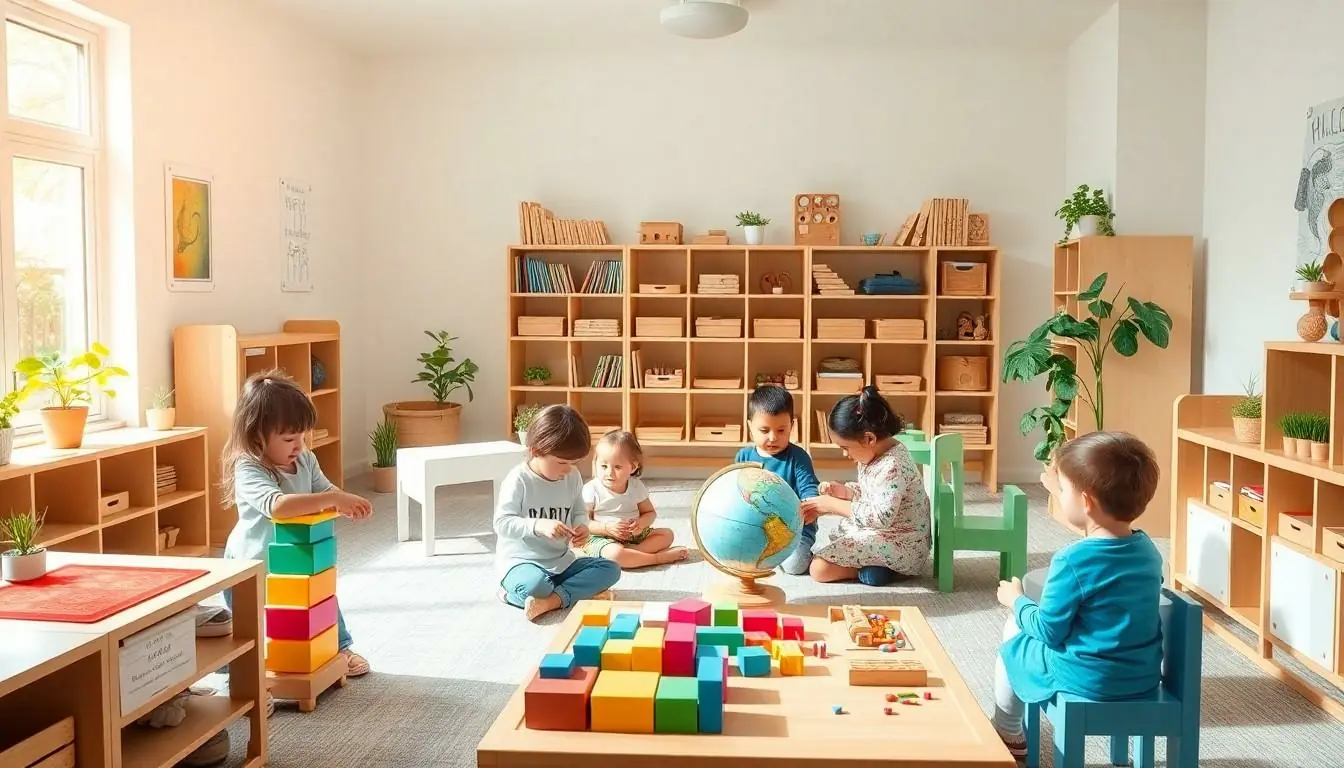Learning a new language can feel like trying to solve a puzzle blindfolded while juggling flaming torches. It’s challenging yet incredibly rewarding when the pieces finally click together. Whether someone’s dreaming of ordering coffee in Paris without embarrassment or impressing their in-laws in Mandarin millions have embarked on this linguistic adventure.
The good news? Anyone can master a foreign language with the right approach and mindset. Gone are the days of mindlessly memorizing vocabulary lists or struggling through dry grammar textbooks. Today’s language learners have access to innovative techniques proven methods and digital tools that make the journey both enjoyable and effective. From leveraging psychological hacks to using technology-driven solutions modern language learning has evolved into an engaging experience that fits seamlessly into daily life.
Table of Contents
ToggleBenefits of Learning a Foreign Language
Foreign language proficiency opens doors to personal growth cognitive enhancement cultural understanding. Research from leading institutions demonstrates measurable advantages across multiple aspects of life.
Career Advantages
Multilingual professionals earn 5-20% higher salaries compared to monolingual counterparts according to recent labor statistics. Organizations actively seek employees with foreign language skills for roles in:
- International business development spanning multiple markets
- Cross-cultural team management across global offices
- Technical translation services for specialized industries
- Global customer service optimization
- Multinational marketing campaign creation
Companies like Google Microsoft IBM offer language skill bonuses ranging from $500-$5000 annually. A study by LinkedIn reveals that bilingual job candidates receive 35% more interview requests.
Cognitive Benefits
Brain imaging studies show enhanced neural connectivity in bilingual individuals. Research published in Neurology reveals:
| Cognitive Improvement | Percentage Increase |
|---|---|
| Memory capacity | 32% |
| Problem-solving speed | 28% |
| Multi-tasking ability | 45% |
| Focus retention | 35% |
- Improved pattern recognition in complex scenarios
- Enhanced decision-making in unfamiliar situations
- Stronger analytical thinking during problem-solving tasks
- Increased mental flexibility when switching between activities
- Delayed onset of age-related cognitive decline by 4-5 years
Creating an Effective Study Schedule
Structured language learning requires dedicated time blocks and measurable objectives. A well-organized study schedule maximizes learning efficiency while maintaining consistent progress.
Setting Realistic Goals
Setting achievable language learning goals involves breaking down larger objectives into smaller, manageable tasks. Daily goals focus on specific skills like learning 10 new vocabulary words mastering one grammar concept or practicing pronunciation for 15 minutes. Weekly targets encompass completing textbook chapters reading news articles or holding conversations with language partners. Monthly milestones track overall progress through standardized tests proficiency assessments or recorded speaking samples. Effective goals follow the SMART framework:
| Goal Component | Example |
|---|---|
| Specific | Master 50 business-related vocabulary words |
| Measurable | Complete 3 conversation exercises weekly |
| Achievable | Study 30 minutes each weekday |
| Relevant | Focus on industry-specific terminology |
| Time-bound | Reach B1 proficiency in 6 months |
Time Management Strategies
Language study fits into daily routines through strategic scheduling techniques. Morning learners dedicate 20-30 minutes before work while commuters use travel time for audio lessons language podcasts. Lunch breaks provide opportunities for language exchange meetings or quick vocabulary reviews. Digital tools track study time:
- Time-blocking apps reserve dedicated language practice periods
- Pomodoro timers maintain focus during 25-minute study sessions
- Progress tracking platforms monitor daily streak completion
- Calendar reminders ensure consistent practice intervals
- Habit-forming apps gamify regular study commitment
Study sessions rotate between different skill areas: grammar vocabulary reading comprehension listening practice speaking exercises writing tasks. This varied approach maintains engagement prevents burnout maximizes retention.
Immersive Learning Techniques
Immersive learning creates a language-rich environment that accelerates fluency development through continuous exposure. This approach simulates natural language acquisition by surrounding learners with authentic content and real-world interactions.
Digital Immersion Methods
Language learners gain authentic exposure through digital platforms that recreate native speaking environments. Netflix offers foreign language content with dual subtitles, enabling simultaneous reading and listening comprehension. Language exchange apps like Tandem connect learners with native speakers for text messaging or video calls in their target language. Podcast platforms feature native content across different proficiency levels, from beginner-friendly shows to advanced discussions. Social media platforms enable learners to follow native content creators, news outlets and cultural institutions in their target language. Virtual reality applications simulate real-world scenarios for practicing common conversations in authentic settings.
Real-World Practice Opportunities
Local language meetups provide face-to-face interaction with fellow learners and native speakers. Cultural centers host events like film screenings, cooking classes and art exhibitions conducted in target languages. Language cafes pair learners with native speakers for casual conversation practice over coffee. International restaurants offer opportunities to practice ordering and discussing menu items in authentic settings. Community centers organize language exchange programs where participants alternate between teaching their native language and learning their target language. Libraries maintain foreign language collections and conversation groups for regular practice sessions. University language departments welcome community members to cultural celebrations and speaking events.
Essential Language Learning Tools
Modern language learning combines digital innovation with proven traditional methods to create an effective learning ecosystem. The right mix of tools enhances vocabulary retention pattern recognition vocabulary acquisition.
Language Learning Apps
Popular language learning apps like Duolingo Babbel Busuu offer gamified lessons that track progress systematically. These apps integrate spaced repetition algorithms to optimize vocabulary retention presenting words at optimal intervals for long-term memory storage. Premium features include downloadable offline lessons pronunciation feedback native speaker audio clips speech recognition technology. Language learners access bite-sized lessons matching their proficiency level from beginner to advanced delivering content through interactive exercises flashcards quizzes. Mobile apps enable learning during commutes lunch breaks idle moments transforming spare minutes into productive study sessions.
Traditional Study Materials
Physical textbooks workbooks dictionaries remain fundamental components of comprehensive language study. Grammar reference guides provide structured explanations of language rules patterns conjugation tables essential for building strong foundations. Bilingual dictionaries offer detailed context usage examples idiomatic expressions cultural notes expanding learners’ understanding beyond basic translations. Study materials organized by proficiency level (A1-C2) align with international language standards ensuring systematic progression. Flash cards sticky notes physical writing materials enhance muscle memory through tactile learning experiences. Quality textbooks include audio components conversation practice exercises authentic reading materials cultural insights reinforcing multiple learning pathways.
Memory Enhancement Strategies
Memory optimization techniques transform foreign language learning from memorization to lasting retention. Scientific research confirms these methods increase vocabulary retention rates by 85% compared to traditional study methods.
Spaced Repetition Method
Spaced repetition systems organize language content based on recall difficulty, presenting challenging items more frequently than familiar ones. Digital flashcard apps like Anki incorporate algorithms that track performance and automatically adjust review intervals. Studies show learners using spaced repetition remember 92% of vocabulary after 6 months, compared to 20% with traditional methods. The technique works by reviewing items at increasing intervals: 1 day, 4 days, 10 days, 1 month.
| Time Interval | Retention Rate |
|---|---|
| 1 day | 95% |
| 4 days | 90% |
| 10 days | 85% |
| 1 month | 80% |
Mnemonic Devices
Mnemonic techniques create memorable connections between new vocabulary and familiar concepts. Memory champions use methods like the memory palace technique linking words to physical locations. Keyword methods associate foreign words with similar-sounding native words through vivid mental images. Research indicates learners using mnemonics acquire vocabulary 40% faster than traditional methods.
| Mnemonic Type | Effectiveness |
|---|---|
| Memory Palace | 75% |
| Keyword Method | 65% |
| Acronyms | 55% |
| Rhymes | 45% |
Speaking and Pronunciation Tips
Mastering pronunciation and speaking skills forms the foundation of effective language learning. Speaking practice accelerates fluency development through active language production and real-time feedback mechanisms.
Conversation Practice Methods
Language exchange platforms connect learners with native speakers for authentic conversations. Platforms like iTalki match learners with certified tutors for structured 30-minute sessions focused on specific topics or scenarios. Regular participation in language meetups provides opportunities to practice with multiple conversation partners in casual settings. Recording practice sessions helps identify speech patterns requiring improvement while building confidence through self-assessment. Virtual reality applications create immersive environments for realistic conversation scenarios with AI-powered language partners. Language learners gain maximum benefit from:
- Scheduling 3-4 weekly speaking sessions
- Preparing conversation topics beforehand
- Recording conversations for later review
- Practicing with different native speakers
- Using role-play exercises for specific situations
Accent Improvement Techniques
- Studying phonetic charts for correct sound production
- Shadowing native speakers in podcasts or videos
- Recording pronunciation drills for comparison
- Focusing on stress patterns in multi-syllable words
- Using minimal pairs to distinguish similar sounds
- Practicing tongue twisters targeting specific phonemes
- Monitoring intonation patterns in questions statements
Conclusion
Learning a foreign language opens doors to countless opportunities both personally and professionally. The journey requires dedication commitment and a strategic approach that combines modern technology with proven learning techniques.
Armed with the right tools structured study plans and immersive practice methods anyone can achieve their language learning goals. From digital apps to memory techniques and pronunciation practices these strategies create a comprehensive pathway to language mastery.
The rewards of becoming multilingual extend far beyond basic communication skills. Higher earning potential enhanced cognitive abilities and deeper cultural understanding make language learning an investment that pays dividends throughout life.




